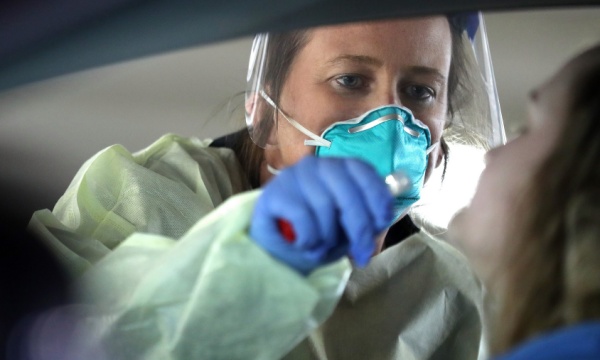By Chris Lisinski
State House News Service
Black Barnstable County residents have contracted COVID-19 at a rate three times as high as the county’s white residents, an “alarming” trend that Cape Cod leaders said warrants passage of emergency sick time legislation and dedicating more resources toward data collection.
Citing new county-level data acquired and published by The New York Times last week, members of the Cape Cod Reopening Task Force warned during a Thursday press call that Black residents are overrepresented in confirmed COVID cases compared to their population in Barnstable County.
“When we see a health disparity that is this stark, even though the data’s preliminary, it’s hard to deny its significance,” said Sen. Julian Cyr, a Truro Democrat.
Public health experts have warned for months that the pandemic is wreaking a disproportionate impact on communities of color, but grasping the full scale of the gaps — and their variations in smaller geographies — has been challenging with incomplete data.
Following a successful lawsuit against the Centers for Disease Control to procure the information, The New York Times published a breakdown of total confirmed cases and infection rates by race or ethnicity in 974 U.S. counties, including all 12 in Massachusetts.
Those data, which cover all cases tracked through May 28 where the individual’s race or ethnicity were known, show an infection rate in Barnstable County of 32 cases per 10,000 white residents and 94 cases per 10,000 Black residents.
That local disparity mirrors both statewide and national trends: people of color are more likely to become infected and to die from the disease than white Americans.
Through May 28, Barnstable County had 1,386 total confirmed cases. Only 49 percent of those had race or ethnicity data available, a common issue for reporting across the country, representing 611 cases involving white residents and 62 involving Black residents. Blacks comprised about 3.7 percent of the county’s population, according to 2018 Census data, but made up 9.2 percent of COVID cases where a race or ethnicity was known.
On the Cape, officials said, the gap reflects the fact that people of color often have less access to health care, live in more crowded conditions where the highly infectious virus can jump from person to person more easily, and are more likely to work in essential frontline roles.
“Social distancing and self-isolation are a luxury that those who live in crowded housing cannot afford,” Cyr said. “That disproportionately affects people of color, particularly migrant workers and seasonal workers.”
Dr. William Agel, chief medical officer at Cape Cod Healthcare, said that the trend underscores the need for state lawmakers to approve legislation making additional emergency paid sick leave available to workers who need it.
Under state law, all employers with 11 or more employees must allow workers to accrue and use up to 40 hours of paid sick time per year. Those who work for smaller companies are only guaranteed access to unpaid time off.
A federal law approved earlier in the outbreak made additional paid time off available to eligible employees afflicted by COVID. At the state level, a Massachusetts bill (H 4700) aimed at offering emergency paid sick time to those not covered by the federal response has not gained traction since it was introduced in April.
“It’s not an issue that changes overnight, but now that the advice to workers is ‘If you’re not feeling great, stay home,’ a lot of workers have no sick time at all, so how can they stay home?” Agel said.
The new batch of data also reflected concerns with how publicly available Massachusetts officials are making information they track.
The Department of Public Health publishes statewide data breaking down confirmed infections, hospitalizations and deaths by race or ethnicity as part of its daily update, and a late June report from the COVID-19 Health Equity Advisory Group unpacked Massachusetts trends and the overlap between communities with the highest infection rates and nonwhite populations.
However, the state has not readily released county- or community-level infection rates by demographic — even though, as Barnstable County Department of Human Services Deputy Director Vaira Harik argued, the DPH must have supplied the data to the CDC for it to appear in the New York Times package.
“I would become a strong advocate of having more immediate access to our data on a county and town basis,” she said on the call. “There should be no reason why we as a county should not have access to our death data in complete form. We should have access to it so we can be as responsive to who is dying and what they look like from various points of view.”
Agel agreed, adding that the medical community “absolutely need(s) more data from both the Department of Public Health and the state to be able to manage this issue.”
Gov. Charlie Baker signed a COVID-19 data reporting bill in June, enshrining in statute requirements for his DPH to report many pieces of data it already publishes as well as more detailed demographic information.
That additional data is typically published in spreadsheets separate from the daily PDF dashboard package the DPH releases every afternoon.
Asked if the new law goes far enough given local concerns raised, Cyr said he does not believe the Legislature needs to impose additional requirements but does need to make more funding available to help health officials track the impact on different populations.
While Massachusetts has a “robust” public health system, the fact that all 351 cities and towns have their own departments makes it “diffuse,” he said.
“The law that we passed is absolutely essential. There’s more information I think we would all like to know, but there’s limitations when you only have so many epidemiologists, so many resources,” Cyr said. “I really view this as a resource problem, so I’m leery of us passing more requirements for data collection without following up with additional resources for DPH and more local health agencies.”
He pointed to an IT and government infrastructure bond bill the Senate approved last week as containing additional money for the DPH’s monitoring programs.
 New Bedford Guide Your Guide to New Bedford and South Coast, MA
New Bedford Guide Your Guide to New Bedford and South Coast, MA








